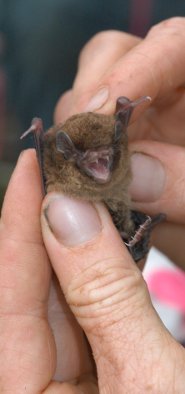 If you think bats can’t be cute, then you’ve never seen the southern Australia’s chocolate wattled bat (Chalinolobus morio). These aerial acrobats sport round fuzzy brown bodies, pink noses and a pug-like face. They are only found in southern Australia, especially in the suburbs of Melbourne and Manna Park. Their only predator is man. Currently, this cute and helpful bat is considered a common species but they rely on roosting areas like trees and attics for hibernation. Should these roosting spots disappear, so will the bats.
If you think bats can’t be cute, then you’ve never seen the southern Australia’s chocolate wattled bat (Chalinolobus morio). These aerial acrobats sport round fuzzy brown bodies, pink noses and a pug-like face. They are only found in southern Australia, especially in the suburbs of Melbourne and Manna Park. Their only predator is man. Currently, this cute and helpful bat is considered a common species but they rely on roosting areas like trees and attics for hibernation. Should these roosting spots disappear, so will the bats.Although southern Australia is not noted for its cold winters, temperatures can plummet to 50 degrees Fahrenheit (10 degrees C). Chocolate wattled bats cannot possibly eat enough insects in order to keep warm, so they slip into a hibernation phase. But during the winter, the insects are not available. They roost together in colonies of 10 to 100 individual bats in order to conserve body heat. If they get disturbed during their hibernation and need to fly, they may starve to death before spring.
Physical Description
Chocolate wattled bats are so small that they are officially listed as "microbats." Adults, both male and female, only tip the scales at 0.3 ounces (9 grams). Their fuzzy brown bodies, nose to tail, are a mere 2.36 inches (60 mm).
Although their eyes are tiny, their ears are large and their heads are crowned with a huge, fur-covered dome. Chocolate wattled bats do not rely on vision during their nocturnal adventures. They instead rely on sound. They emit a high-pitched shriek that bounces of objects. The bat’s brain translates these sounds much like modern sonar. Chocolate wattled bats are also listening for the sounds emitted from their prey – flying insects such as moths. They can hear frequencies as soft as 50 kilohertz (kHz), while human hears can only detect frequencies up to 15 kHz.
Life Cycle and Behavior
Unlike many others of Australia’s native mammals, chocolate wattled bats give birth to their young rather than use a pouch. Babies are born naked. In comparison to their mothers, these babies are huge – up to 30 percent the mother’s own weight. Mothers take tender care of their young and nurse them up to two months. Since the mothers cannot stay in the cave all of this time, only a couple of adult females are left with the babies each night in a crèche while the other mothers go out to feed. Mother bats take turns at who guards the crèche.
Microbats have very high metabolisms due to their tiny bodies. They need to eat at lest half of their body weight every night in order to stay alive. One colony of chocolate wattled bats can help keep the population of annoying night-flying insects to a manageable level.
Picture of the chocolate wattled bat by Doug Beckers, licensed under the Creative Commons Attribution-Share Alike 2.0 Generic license.
The Chocolate wattled bat is listed as Least Concern (LR/lc), lowest risk. Does not qualify for a more at risk category. Widespread and abundant taxa are included in this category, on the IUCN Red List of Threatened Species
Namings for the chocolate wattled bat
A young / baby of a chocolate wattled bat is called a 'pup'. A chocolate wattled bat group is called a 'colony or cloud'.Countries
Australia
Custom Search